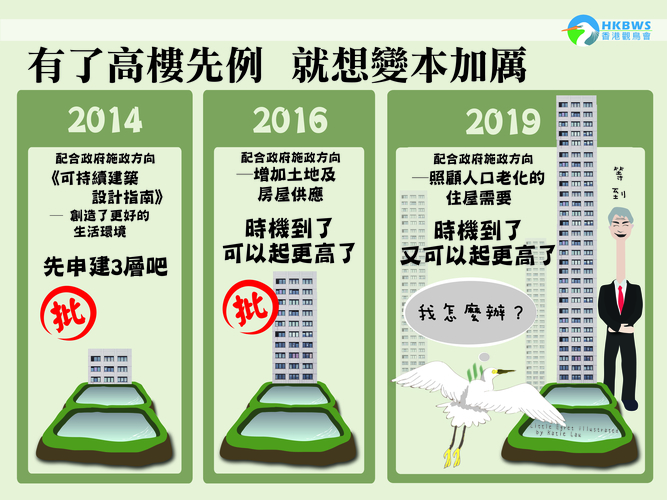
24 October 2019
The study on the Ecological Value of Fish Ponds in the Deep Bay Area in 1997 confirmed fishponds are of important ecological value. As fishponds have strong ecological connections with the Mai Po Marshes, we should conserve the continuous fishponds and wetlands in the Deep Bay area including those at Fung Lok Wai, Nam Sang Wai, Lut Chau, San Tin, Ma Tso Lung, etc., in order to maintain the ecological integrity of the Deep Bay wetland ecosystem. Besides, the report also mentioned the egretries in the Deep Bay area. The breeding egrets would head to the Deep Bay wetlands for foraging, but they tend to avoid land with open storage uses (commonly called brownfields), residential areas and construction sites during their flight. So to protect these egrets, there needs to be adequate protection to their nesting location, foraging ground and flight path. Finally, the Government established the “Wetland Conservation Area” (WCA) and “Wetland Buffer Area” (WBA) in 1999.
In the past decade, the Government’s policy direction is often being used as a profit making tool for developers. Take this piece of land south of Nam Sang Wai near Ho Chau Road as an example. It is located within the WBA, but has been successful in applying for increase in development intensity and building height, so as to match with the Government’s policy adjustments. Back in 2013, the developer already submitted residential development of 65 three-storey houses at this location to the Town Planning Board (TPB) and it was approved in 2014 (A/YL-NSW/224). In the same year, the developer submitted another application (A/YL-NSW/233) to increase the building height up to 12 storeys, claiming to be in line with the Government’s policy of increasing land and housing supply. TPB eventually approved the application with conditions for residential blocks up to 10 storeys high. Recently, the developer Sun Hung Kai (SHK) submitted yet another development application of eight 6- to 29-storey residential blocks at the same location (A/YL-NSW/274), claiming to provide “cross-generation co-living housing” to match with the Government’s policy of “ageing-in-place”. It seems that the Government’s policy has relaxed the development restrictions in ecological sensitive areas.
In addition, the consultancy report provided by the developer in 2014 stated about 70% of the flight lines from the Tung Shing Lei egretry heads towards the north, which would in fact pass through the current application site and other nearby proposed residential developments (planning application no.: Y/YL-NSW/4, Y/YL-NSW/3, A/YL-NSW/242, A/YL-NSW/267and A/YL-NSW/241). The approval of the current application would set an undesirable precedent for high-rise development with increased intensity in the area, which may form a barrier that obstructs breeding egrets to access the Deep Bay wetlands for foraging, and builds up the development pressure in the Nam Sang Wai area and the WBA. We consider that any developments within the Deep Bay area should strictly follow the planning regulations of the WCA and WBA, such that the integrity of the Deep Bay wetland ecosystem can be protected.
????Gist of the planning application: https://bit.ly/2PevzYg
✒HKBWS's submission: https://bit.ly/2pb2rq1
????Read more at "Deep Bay in a minute": https://bit.ly/34tltYe



